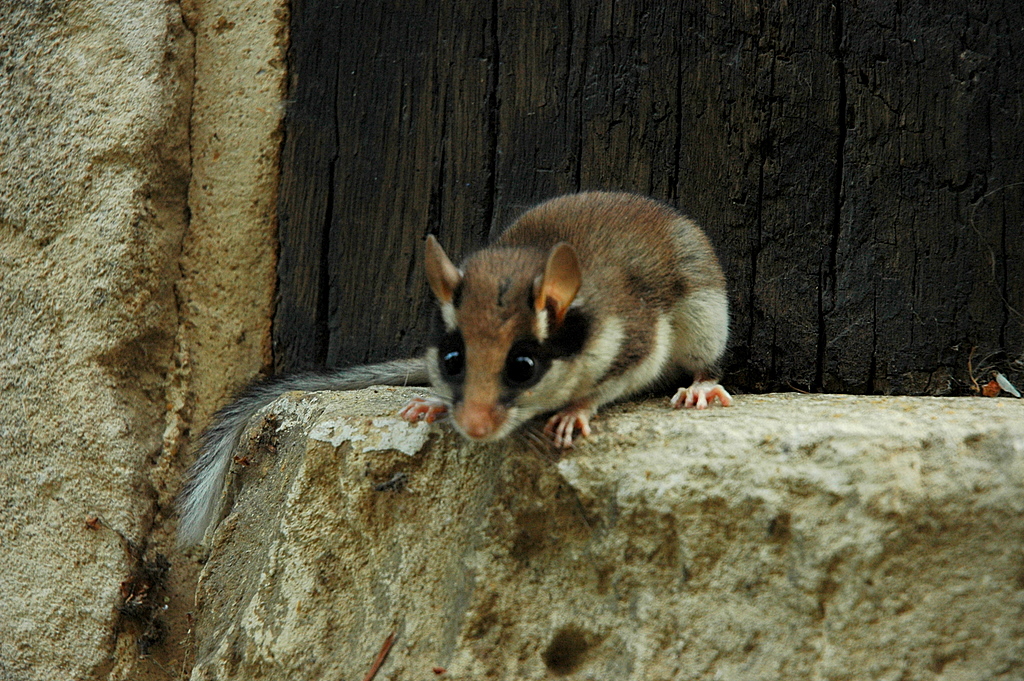- Garden dormouse
Taxobox | name = Garden dormouse
status = VU
status_system = iucn2.3

image_width = 280px
image_caption = Garden dormouse ("Eliomys quercinus")
regnum =Animalia
phylum =Chordata
classis =Mammalia
subclassis =Placentalia
ordo =Rodent ia
subordo =Sciuromorpha
familia = Gliridae
genus = "Eliomys "
species = "E. quercinus"
binomial = "Eliomys quercinus"
binomial_authority = Linnaeus, 1766The garden dormouse ("Eliomys quercinus") is a
rodent in thedormouse family.Features
Dormice are typically convert|10|to|15|cm|abbr=on in length, with the tail adding an additional convert|8|to|14.5|cm|abbr=on. It weighs convert|60|to|140|g|abbr=on. The coat is gray or brown, with a white underside. The garden dormouse can be recognized by black eye markings, relatively large ears, short hair, and a white tassel at the end of the tail.
Range and habitat
In spite of its name, the garden dormouse's main habitat is the forest, though it can also be found in fruit-growing regions. It is particularly common in southern
Europe , but its range extends into the north. Garden dormice are often found in theAlps , in theBavarian Forest , and in the Ore Mountains.The species is also present in northern Germany, but the population there is apparently not capable of large-scale reproduction. Nearby, in the
Netherlands , it is nearly extinct: in 2007 researchers reported finding only nine animals in two woods in the province of Limburg, where it used to be common. They suggested this is a result of the landscape becoming increasingly monotonous and due to climate change, which they said interrupts hibernation. [Citation | title = Eikelmuis, ook wel slaapmuis of fruitdief genoemd, bijna uitgestorven | newspaper =Trouw | pages = 7 | date = September 19 2007 | language = Dutch]Way of life
Garden dormice are primarily
nocturnal , sleeping in spherical nests in trees during the day. At night they look for food, mainly eating largerinsects likegrasshopper s andbeetle s,snail s, eggs, young nestlings, small mice, andspider s, as well as berries,fruit , and nuts likeacorn s andbeech nuts. While omnivorous, the diet of dormice contains slightly more animal protein than vegetation.The mating period lasts from April to June. During this time, the female indicates her readiness to mate by squeaking loudly. The young are usually born in litters of three to seven, after a
gestation period of 23 days. Blind and naked at birth, they open their eyes after about eighteen days, and are nursed until they are one month old. They become independent at two months of age, but do not reach sexual maturity until the next year. They have a life expectancy of about five years.It is not unusual for a garden dormouse to eat one of its unfortunate rivals during the mating season. Cannibalism is also observed occasionally when the animal is coming out of hibernation.
Classification
On the islands of the
Mediterranean Sea there are several subspecies of garden dormouse, all of which are very rare. These are the Sardinian garden dormouse ("E. q. sardus"), the Sicilian garden dormouse ("E. q. dichrurus") and the Liparian garden dormouse ("E. q. liparensis"). The populations of western Asia and north Africa, on the other hand, have recently been separated into their own species "Eliomys melanurus".References
* Listed as Vulnerable (VU A1c v2.3)
* [http://www.itis.usda.gov/servlet/SingleRpt/SingleRpt?search_topic=TSN&search_value=584970 ITIS report]:"This article includes information translated from the German and French Wikipedias."
Wikimedia Foundation. 2010.
